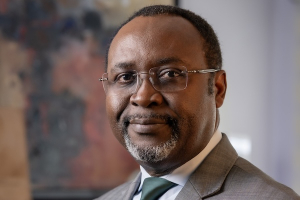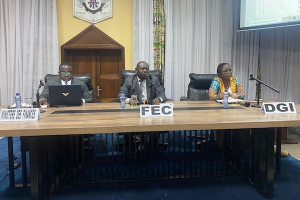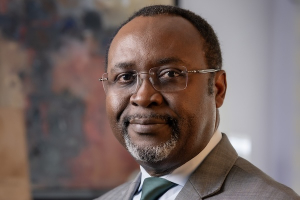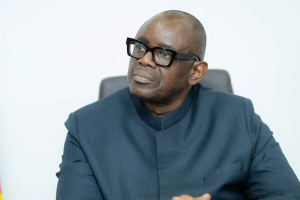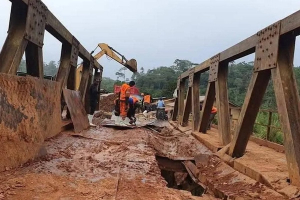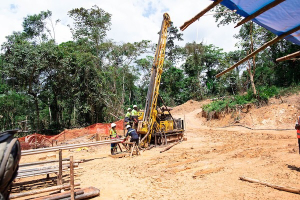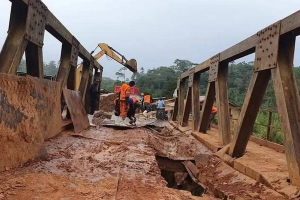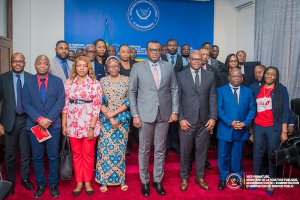Equipe Publication
Albert Zeufack Urges National Priority on Job Creation in DR Congo
Marking the International Day for the Eradication of Poverty, Albert Zeufack, the World Bank’s Country Operations Director for the Democratic Republic of Congo (DRC), Burundi, Angola, and São Tomé and Príncipe, urged a nationwide effort to focus on creating decent, well-paid jobs in the DRC.
Drawing on more than three decades of experience in economic development, the Cameroonian economist warned that the country must urgently link economic growth to social inclusion or poverty will continue to defy current efforts.
Zeufack noted that despite a 17% rise in GDP per capita between 2020 and 2024, poverty only declined slightly, from 85% to 81.1%. He said this limited progress stems from growth being driven mainly by the mining sector, which generates few jobs. World Bank data show a negative employment-to-growth elasticity of -1.46 during this period, meaning the economy expanded while employment contracted. Zeufack argued that this capital-intensive model is deepening inequality and weakening social cohesion.
He called for structural reforms to diversify growth drivers and invest in sectors that can create sustainable employment. He stressed the need to cut business costs, improve infrastructure, and boost connectivity—particularly roads, electricity, railways, and digital networks—while making major investments in human capital and technical skills.
The World Bank’s current project portfolio reflects this strategy. Zeufack cited the Inga 3 Development Program (PDI3), the Lobito Corridor, and the PACT Corridor linking Mbuji-Mayi with the country’s eastern regions, all of which combine infrastructure expansion with job creation. PDI3, he explained, goes beyond building a hydroelectric dam; it aims to establish an environment for power generation and distribution, a key driver of industrialization.
He described the Lobito Corridor, which connects the mining regions of Katanga to the Atlantic coast, as a crucial tool for economic diversification. The project, he said, should help create special economic zones, develop secondary cities, and strengthen agricultural value chains — a necessary break from the DRC’s extraction-driven economy.
Zeufack concluded by saying that the DRC’s economic performance should no longer be measured by GDP alone, but by its capacity to generate quality jobs and reduce poverty. Reconnecting growth with employment and social well-being, he said, must be central to the country’s development model if it is to turn its vast potential into shared prosperity and meet the demographic challenge it faces by 2050.
Boaz Kabeya
DRC grants new delay to rollout of standardized invoice for VAT reform
The Democratic Republic of Congo (DRC) has again postponed the introduction of its standardized invoice system, a key reform intended to strengthen value-added tax (VAT) collection. Initially scheduled for July 1, 2025, and later pushed to August 1, the mandatory phase will now begin on December 1, 2025, according to a statement from the Directorate General of Taxes (DGI) dated October 2.
The reform is designed to make VAT collection more secure through the use of approved billing software connected to the Electronic Fiscal Device (DEF), which allows tax authorities to access real-time data on commercial transactions. It applies to all VAT-registered companies with annual revenues equal to or above 80 million Congolese francs (FC).
While the DGI did not specify reasons for this second delay, a meeting on August 20 between the Ministry of Finance, the DGI, and the Federation of Congolese Businesses (FEC) highlighted several technical and operational obstacles. These include the approval process for billing systems, conditions for effective implementation, and special cases for certain industries.
Many companies reported difficulties accessing the DGI’s website (developper.dgirdc.cd), which was launched on June 16 to allow registration and submission of billing software approval requests. As of late August, the system was still partially inoperative.
Another issue concerns the fiscal clearance certificate (quitus fiscal) required for submitting approval requests, despite an ongoing moratorium on the quitus until December 31, 2025. Finance Ministry experts clarified that the requirement applies only to software vendors. Companies can instead submit a letter confirming that a quitus request has been filed but not processed within the legal 10-day period.
The FEC also raised concerns about data security, requesting safeguards against hacking or misuse. It further noted that the list of approved software providers—intended to help firms still using manual invoicing comply with the reform—had not yet been published. The DGI responded that two vendors had been accredited and that their details would soon be available online, along with permanent support services to assist companies.
Sector-specific issues were also discussed, particularly for the mining, oil, cement, insurance, telecommunications, and mobile money industries, which have asked that their operational specificities be considered.
The FEC requested an evaluation session before the mandatory phase begins. The DGI and Finance Ministry experts agreed, confirming that a meeting would take place ahead of full enforcement.
Part of the government’s broader tax modernization strategy, the standardized invoice system aims to track business transactions, secure VAT revenue, curb fraud, improve fiscal reporting, and increase domestic revenue.
At the 10th Expobéton Forum held on October 9, 2025, in Kinshasa, DGI Director General Barnabé Muakadi Muamba said VAT currently generates about 320 billion FC per month, but the rollout of the standardized invoice could triple that amount.
Albert Zeufack appelle à faire de l’emploi une priorité nationale en RDC
À l’occasion de la Journée internationale pour l’élimination de la pauvreté, Albert Zeufack, directeur des opérations de la Banque mondiale pour la République démocratique du Congo (RDC), le Burundi, l’Angola et Sao Tomé-et-Principe, appelle à une action concertée pour placer la création d’emplois de qualité au rang de priorité nationale en RDC. Fort de plus de trente ans d’expérience dans le développement économique, l’économiste camerounais estime que le pays doit impérativement relier croissance économique et inclusion sociale, faute de quoi la pauvreté continuera de résister aux efforts entrepris.
Il rappelle que, malgré une hausse du PIB par habitant de 17 % entre 2020 et 2024, la pauvreté n’a reculé que faiblement, passant de 85 % à 81,1 %. Cette évolution limitée s’explique par une croissance largement tirée par le secteur minier, peu créateur d’emplois. Les données de la Banque mondiale révèlent d’ailleurs une élasticité emploi-croissance négative (-1,46) sur la période. Conclusion : l’économie a progressé, mais l’emploi a reculé. Ce modèle capitalistique, selon lui, accentue les inégalités et fragilise la cohésion sociale.
Pour Albert Zeufack, la RDC doit engager une transformation structurelle en diversifiant les moteurs de croissance et en investissant dans des secteurs capables de générer des emplois décents et durables. Il met en avant la nécessité de réduire les coûts liés à l’environnement des affaires, d’améliorer les infrastructures et de renforcer la connectivité — routes, électricité, chemins de fer, numérique — tout en investissant massivement dans le capital humain et les compétences techniques.
Le portefeuille de projets soutenus par la Banque mondiale reflète déjà cette vision. Zeufack cite notamment le Programme de développement Inga 3 (PDI3), le corridor de Lobito et le corridor PACT reliant Mbuji-Mayi à l’est du pays, qui visent à associer le développement des infrastructures à la création d’emplois. Le PDI3, par exemple, ne se limite pas à la construction d’un barrage hydroélectrique : il vise à créer un environnement favorable à la production et à la distribution d’énergie, levier essentiel pour l’industrialisation.
Concernant le corridor de Lobito, il y voit un instrument de diversification économique. En reliant les zones minières du Katanga à la côte atlantique, ce projet devrait stimuler l’émergence de zones économiques spéciales, favoriser le développement des villes secondaires et renforcer les chaînes de valeur agricoles. Selon lui, il s’agit d’une rupture nécessaire avec une économie centrée sur l’extraction et peu inclusive.
Albert Zeufack conclut en soulignant que la performance économique de la RDC ne doit plus être évaluée uniquement à travers le PIB, mais surtout à travers sa capacité à créer des emplois de qualité et à réduire la pauvreté. Reconnecter la croissance à l’emploi et au bien-être social doit devenir le cœur du modèle de développement congolais. À ce prix, dit-il, la RDC pourra transformer son potentiel économique en prospérité partagée et relever le défi démographique qui l’attend d’ici 2050.
Boaz Kabeya
Lire aussi :
RDC : vitrine des ambitions africaines du Camerounais Albert Zeufack
Inga 3, routes, réformes… : Kinshasa en voie d’obtenir 1,5 milliard $ de la Banque mondiale
La Banque mondiale souhaite accélérer ses projets en RDC, estimés à 7,3 milliards $
Facture normalisée : nouveau moratoire sur une réforme clé de la TVA en RDC
Initialement prévue pour le 1er juillet 2025, la délivrance et l’exigence de la facture normalisée ont de nouveau été reportées. Après un premier décalage au 1er août, la Direction générale des impôts (DGI) a annoncé, dans un communiqué daté du 2 octobre, que la phase obligatoire de cette réforme n’interviendra finalement qu’à partir du 1er décembre 2025.
La facture normalisée vise à sécuriser la collecte de la taxe sur la valeur ajoutée (TVA) en République démocratique du Congo (RDC). Elle repose sur l’utilisation de logiciels de facturation homologués et connectés au dispositif électronique fiscal (DEF), permettant à l’administration fiscale d’obtenir en temps réel les informations sur les transactions commerciales. La réforme concerne toutes les entreprises assujetties à la TVA, c’est-à-dire celles dont le chiffre d’affaires annuel est égal ou supérieur à 80 millions de francs congolais (FC).
Dans son communiqué, la DGI n’explique pas les raisons de ce second report. Mais lors d’une rencontre organisée le 20 août 2025 entre le ministère des Finances, la DGI et la Fédération des entreprises du Congo (FEC), plusieurs défis techniques et opérationnels avaient été relevés. Ils concernent notamment la procédure d’homologation des systèmes de facturation, les préalables pour une mise en œuvre effective de la réforme et les cas particuliers de certains secteurs d’activité.
De nombreuses entreprises ont signalé des difficultés d’accès au site web de la DGI (developper.dgirdc.cd), censé permettre la création de comptes et le dépôt des demandes d’homologation des systèmes de facturation d’entreprise (SFE). Lancée le 16 juin 2025, cette procédure restait encore partiellement inopérante fin août.
Autre sujet de préoccupation : l’exigence du quitus fiscal pour introduire un dossier d’homologation, alors qu’un moratoire sur le quitus est en vigueur jusqu’au 31 décembre 2025. Les experts du ministère des Finances et de la DGI ont précisé que cette obligation ne concerne que les éditeurs de logiciels. Les entreprises, elles, peuvent se contenter d’une lettre attestant que la demande de quitus a été déposée mais que l’administration ne l’a pas délivré dans le délai légal de dix jours.
Hausse des recettes en perspective
La FEC a également soulevé la question de la sécurité des données des entreprises, demandant des garanties contre le piratage ou une utilisation abusive. Les représentants du patronat ont en outre rappelé que la liste des fournisseurs de solutions, censée permettre aux entreprises utilisant encore la facturation manuelle de se conformer à la réforme, n’était pas publiée. La DGI a répondu que deux distributeurs étaient déjà agréés et que leurs identités seraient bientôt disponibles en ligne. Elle a également annoncé la mise en place d’une assistance permanente pour accompagner les entreprises dans leurs démarches.
Des préoccupations sectorielles spécifiques ont aussi été exprimées, notamment par les acteurs des industries minière, pétrolière, cimentière, ainsi que par les assurances, les télécommunications et les services de mobile money, qui souhaitent que leurs particularités soient prises en compte.
Lors de la même rencontre, la FEC a demandé qu’une séance d’évaluation de la phase de conformité soit organisée avant le lancement de la phase obligatoire. Les experts du ministère et de la DGI ont donné leur accord, confirmant qu’une réunion aura lieu avant l’entrée en vigueur stricte de la réforme.
La facture normalisée s’inscrit dans la stratégie de modernisation du système fiscal congolais. Ses objectifs sont de tracer les transactions commerciales, sécuriser la collecte de la TVA, réduire la fraude, fiabiliser les déclarations fiscales et accroître les recettes internes.
Lors de la 10ᵉ édition du forum Expobéton, tenue le 9 octobre 2025 à Kinshasa, le directeur général de la DGI, Barnabé Muakadi Muamba, a rappelé l’impact attendu de la réforme : la TVA rapporte actuellement environ 320 milliards de FC par mois, mais la généralisation de la facture normalisée pourrait multiplier ce montant par trois.
Timothée Manoke
Lire aussi :
Facturation : seuls les logiciels homologués autorisés dès le 1er juillet en RDC
TVA : la RDC prévoit d’étendre la collecte automatisée à toutes les entreprises en 2025
Fraude fiscale : 11 038 entreprises indexées en RDC, une hausse des recettes de 30 % projetée
DR Congo Clarifies 'Development Work' Definition to Enforce Mine Titles
Louis Watum Kabamba, the Democratic Republic of Congo’s Minister of Mines, signed a ministerial order on September 8, 2025, precisely defining the scope of "development and construction work" required to validate mining exploitation rights and permanent quarry authorizations.
Previously, the Mining Code and Regulations mandated that title holders commence work within fixed deadlines—one year for exploration permits and one to three years for exploitation authorizations—but failed to specify the exact nature of the required activities.
The new order addresses this ambiguity by providing a concrete definition of the activities that qualify a project as officially launched. The required activities must align with the planning detailed in the approved feasibility study and the Environmental and Social Impact Assessment. The text specifies that a title or quarry holder "must comply with the work planning contained in the approved feasibility study" to attest that work has commenced.
Article 1 of the decree defines development and construction work to include operations for accessing the deposit, preparatory work, extraction, hauling, storage, and setting up processing facilities. These activities also cover the construction of buildings and infrastructure directly related to mining operations.
Articles 5 and 6 further clarify recognized work types, encompassing surface infrastructure and site preparation such as overburden stripping, the construction of buildings, shafts, ramps, roads, camps, and electrical and hydraulic networks, as well as processing and transformation plants. Recognized underground work includes shaft sinking, installation of mining equipment, underground electrification, ventilation and dewatering systems, and crushing and loading stations. Preliminary work, as defined in Article 4, includes perimeter boundary marking, site security, and access road development.
Increased Surveillance and Deadline
This order is issued amid intensified scrutiny of inactive mining titles. On August 20, 2025, the Mining Cadastre (CAMI) published a list of 93 titles threatened with cancellation for failure to start work. Companies on the list included Tenke Fungurume Mining for two titles covering six squares in Lubudi (Lualaba) and Cimenterie de Lukala (Cilu) for one title covering five squares in Songolo (Kongo Central).
On September 5, 2025, CAMI granted the concerned title holders 45 days to present their defense and prove the effective start of operations. This deadline expires on October 20, 2025. After this date, companies that have not demonstrated the commencement of the defined work will face the forfeiture of their mining rights.
Forfeiture decisions are made by the Minister of Mines, and affected title holders have 30 days to file an administrative appeal. If no appeal is filed, the decision becomes final, and the relevant perimeters return to the state's public domain as Geological Research Zones (ZRG).
The signing of this decree is part of a broader push to reorganize the mining sector. Prior to Watum Kabamba’s appointment in August, a massive effort to clean up the cadastral register resulted in the release of 594 mining and quarry titles, representing 37,253 mining squares (31,648 sq km), making them available to new investors.
With over thirty years of mining experience, Minister Watum intends to continue this rationalization drive. By promoting modernized governance and enhancing sector attractiveness, he aims to establish a more stable and transparent investment climate.
Timothée Manoke
Work Begins to Reopen Abombi Bridge Linking Mungwalu to Bunia
Rehabilitation work officially began on October 13, 2025, on the Abombi Bridge in Djugu territory, part of an effort to reopen a key road linking the Mungwalu mining area to Bunia, the capital of Ituri province.
The project, funded by the provincial government and carried out by local firm Sous le Palmier, focuses on the Iga Barrière-Mungwalu road section.
Before work began, the bridge was badly deteriorated, making it difficult for trucks and traders to cross. Vehicles often got stuck, and frequent accidents effectively cut off Mungwalu from the rest of the province, disrupting shipments of minerals, farm produce, and essential goods.
Engineer Joël Kilongo, who oversees the site, said the work mainly involves replacing old materials and strengthening the bridge’s structure.
The rehabilitation is expected to last about two months and is part of a broader series of infrastructure projects launched by provincial authorities to improve access to mining areas and facilitate the movement of goods and people along Ituri’s main economic corridors.
Boaz Kabeya
China's Chengtun Buys Loncor Gold, Securing Adumbi Gold Project
Chinese mining group Chengtun Mining has agreed to acquire Canadian gold exploration company Loncor Gold in an all-cash transaction valued at C$261 million (about $186 million), gaining control of the Adumbi gold deposit in the Democratic Republic of Congo (DRC).
Loncor and Chengtun announced the definitive arrangement agreement on October 14, 2025. Under the terms, Chengtun will purchase all outstanding common shares of Loncor for C$1.38 per share.
The current proposal represents a 33% premium to Loncor’s 30-day volume-weighted average share price and a 16% premium to its closing price on the Toronto Stock Exchange (TSX) on October 10, 2025. The announcement did not specify if the offer was related to an unsolicited, non-binding bid Loncor received from a third-party investor three months ago.
Loncor holds an 84.68% stake in the Adumbi deposit, which is located in the Ngayu greenstone belt in northeastern DRC, with the Congolese state mining company Sokimo holding the remaining 10%. Adumbi's resources were estimated at 3.66 million ounces of gold in a 2021 preliminary economic assessment.
Deal Structure and Approvals
The agreement includes customary protective clauses, such as a non-solicitation clause and a "fiduciary out" provision that allows Loncor to accept a superior proposal, provided Chengtun is given the right to match the bid. The parties also agreed to reciprocal termination fees of C$10 million under certain conditions.
All outstanding Loncor stock options and warrants will be cashed out for an amount equal to the difference between the transaction consideration and the exercise price. Furthermore, Chengtun will provide Loncor with $3 million in repayable advances within 60 days of signing, intended for the Adumbi exploration program and general corporate needs.
The transaction will be implemented via a plan of arrangement under the Ontario Business Corporations Act and requires approval from two-thirds of Loncor shareholders, TSX acceptance, and necessary regulatory clearances. Closing is expected in the first quarter of 2026, after which Loncor shares will be delisted from the TSX.
Major Loncor shareholders, including Resolute Mining (18%) and Arnold Kondrat (17%), along with the entire board of directors, have signed support agreements, collectively representing about 38% of outstanding shares. The board, supported by a special committee of independent directors, deemed the offer fair and in the best interest of shareholders, with Stifel Canada providing a fairness opinion on the price.
Chengtun’s Expansion into Gold
The acquisition will mark Chengtun’s entry into the gold sector, adding the Adumbi deposit and potential development of other gold projects in the Ngayu belt, such as the Imbo project, to its portfolio.
Chengtun is already active in the DRC’s base metals sector through its subsidiary Congo Chengtun Mining, located in Kolwezi (Lualaba), which focuses on copper, cobalt, and nickel. Its Kalongwe project is expected to produce an estimated 22,600 tons of copper and 3,700 tons of cobalt annually, with plans for a hydrometallurgical plant to process the local ore.
Ronsard Luabeya
Or : le Chinois Chengtun en passe de prendre le contrôle du gisement d’Adumbi
Le groupe minier chinois Chengtun Mining s’apprête à acquérir Loncor Gold, société canadienne spécialisée dans l’exploration aurifère et propriétaire du gisement d’Adumbi, situé dans la ceinture de roches vertes de Ngayu, dans le nord-est de la République démocratique du Congo (RDC). Loncor détient 84,68 % de ce gisement, tandis que l’État congolais, via la société Sokimo, en possède 10 %.
Dans un communiqué publié le 14 octobre 2025, Loncor et Chengtun ont annoncé la conclusion d’une convention d’arrangement. Selon ses termes, Chengtun rachètera la totalité des actions ordinaires en circulation de Loncor au prix de 1,38 dollar canadien par action, pour une transaction entièrement en numéraire évaluée à 261 millions de dollars canadiens, soit environ 186 millions de dollars américains.
Il y a trois mois, Loncor avait indiqué avoir reçu une offre non sollicitée et non contraignante d’un investisseur tiers. Un comité spécial d’administrateurs avait été mis en place pour l’analyser. Le communiqué ne précise pas s’il s’agit de cette même offre. Il souligne en revanche que la proposition actuelle représente une prime de 33 % par rapport au cours moyen pondéré sur 30 jours et de 16 % par rapport au cours de clôture de l’action le 10 octobre 2025 à la Bourse de Toronto (TSX).
Avances et modalités
L’accord inclut des clauses classiques de protection, comme une clause de non-sollicitation et une clause de « renonciation fiduciaire », permettant à Loncor d’accepter une offre supérieure tout en donnant à Chengtun le droit d’aligner sa proposition. Les deux parties se sont également entendues sur des frais de résiliation réciproques de 10 millions de dollars canadiens dans certaines conditions.
Les options d’achat d’actions et bons de souscription de Loncor en circulation seront rachetés au comptant, pour un montant égal à la différence entre la contrepartie et le prix d’exercice. Par ailleurs, Chengtun versera à Loncor 3 millions de dollars américains d’avances remboursables dans les 60 jours suivant la signature, destinées au programme d’exploration d’Adumbi et aux besoins généraux de l’entreprise.
La transaction sera mise en œuvre via un plan d’arrangement approuvé par la Cour supérieure de l’Ontario, conformément à la loi sur les sociétés par actions de la province. Elle reste soumise à l’approbation des actionnaires de Loncor à la majorité des deux tiers, à l’acceptation de la TSX et aux autorisations réglementaires nécessaires. La clôture est attendue au premier trimestre 2026, après quoi les actions de Loncor seront radiées de la Bourse de Toronto.
Expansion aurifère et diversification
Les principaux actionnaires de Loncor, dont Resolute Mining (18 %) et Arnold Kondrat (17 %), ainsi que l’ensemble du conseil d’administration, ont signé des accords de soutien à la transaction, représentant environ 38 % des actions en circulation. Le conseil, appuyé par un comité d’administrateurs indépendants, a jugé l’offre équitable et dans l’intérêt des actionnaires. La banque Stifel Canada a confirmé que le prix proposé est financièrement juste.
L’acquisition de Loncor permettrait à Chengtun de prendre le contrôle du gisement d’Adumbi, dont les ressources sont estimées à 3,66 millions d’onces d’or, selon une étude économique préliminaire publiée en 2021. Le groupe pourrait également développer d’autres projets aurifères dans la ceinture de Ngayu, notamment le projet Imbo.
Déjà actif en RDC dans le cuivre, le cobalt et le nickel, Chengtun ferait ainsi son entrée dans le secteur aurifère. Sa filiale Congo Chengtun Mining, implantée à Kolwezi (Lualaba), développe le projet Kalongwe, avec une production annuelle estimée à 22 600 tonnes de cuivre et 3 700 tonnes de cobalt, et prévoit la construction d’une usine hydrométallurgique pour valoriser le minerai local.
Ronsard Luabeya
Lire aussi :
Gisement d’or d’Adumbi : Loncor Gold dans le viseur des investisseurs
Ituri : le pont Abombi en reconstruction pour relancer le trafic Bunia–Mungwalu
Les travaux de réhabilitation du pont Abombi, situé sur le tronçon routier Iga Barrière–Mungwalu, dans le territoire de Djugu, ont été lancés le 13 octobre 2025. Financé par le gouvernement provincial et exécuté par l’entreprise Sous le Palmier, ce chantier vise à rétablir la circulation sur cet axe essentiel reliant la zone minière de Mungwalu à la ville de Bunia, chef-lieu de la province de l’Ituri.
Avant ce lancement, le pont Abombi se trouvait dans un état avancé de dégradation, provoquant de grandes difficultés pour les transporteurs et les commerçants. Des véhicules s’y embourbaient régulièrement et plusieurs accidents avaient été signalés, isolant temporairement Mungwalu du reste de la province. Cette situation perturbait non seulement l’évacuation des produits miniers et agricoles, mais aussi l’approvisionnement en biens de première nécessité.
Selon l’ingénieur Joël Kilongo, responsable du chantier, les travaux consistent principalement à remplacer les anciens matériaux et à renforcer la structure.
Prévue pour durer environ deux mois, la réhabilitation du pont Abombi s’inscrit dans une série de projets d’infrastructures lancés par les autorités provinciales pour désenclaver les zones minières et améliorer le transport des biens et des personnes sur les principaux axes économiques de l’Ituri.
Boaz Kabeya
DRC plans treasury deal with banks to ensure timely public wage payments
The Democratic Republic of Congo (DRC) plans to establish a treasury agreement with commercial banks involved in paying civil servants to guarantee fixed-date salary payments, as the state continues to face liquidity constraints.
According to the Ministry of Public Service, Administrative Modernization, and Public Service Innovation, Minister Jean-Pierre Lihau met on October 8 with bank representatives to discuss the arrangement. Under the plan, banks would advance salaries to public employees, with the government repaying them later with interest.
Data from the Central Bank of Congo (BCC) show that short-term state borrowing rates average 10% annually. At that rate, the potential market for banks could reach about $40 million per year, given that the revised 2025 budget estimates the public wage bill at $4 billion.
Talks also include a proposed pension advance mechanism under which banks would pre-finance retirees’ benefits, reimbursed by the state through monthly installments equivalent to their former salaries, plus interest. This reform, first presented in July 2025, has resurfaced for review.
The Ministry of Budget aims to start payments on the 15th of each month, prioritizing police, military, and teachers. However, delays of up to two weeks persist due to tight treasury conditions. In September, the deficit reached 83.8 billion Congolese francs, with revenues of 3,317.2 billion francs against expenditures of 3,401.2 billion, according to an October 3 economic bulletin.
To address these gaps, the government now plans to rely on bank advances. Financial institutions have expressed readiness to support the initiative, which mirrors the mechanism used to settle the state’s fuel subsidy debts and could take effect in 2026.





